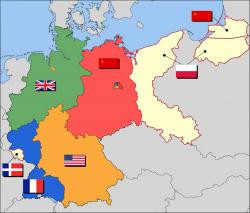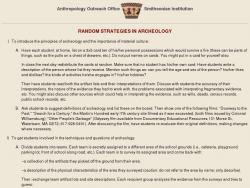Kate Harris
Social Studies teacher
Pittsburgh CAPA
Middle School (13 to 15 years old), High School (16 to 18 years old)
Teacher/Educator
Language Arts And English, Civics, Literature, Cultures, Economics, Social Studies, Geography, Writing, US History, Arts, Other
I'm a history-lover, art fan, and bookworm. I taught high school history (U.S. History and World Religions) for ten years in North Carolina, teach currently in Pittsburgh, PA, and am working to help teachers make the most of this new resource!
Kate Harris's collections
Building the Berlin Wall
This teaching collection explores the Berlin crisis leading to the building of the Berlin Wall. It addresses the following guiding questions through primary/secondary sources and teaching suggestions:
-Why was Berlin the center of crisis in between 1958-1961?
-Why did the Soviet Union sanction the construction of the Berlin Wall?
-Why did the United States allow it to happen?
-How did the Wall affect the lives of East and West Berliners?
-Does the end (no more crises in Berlin) justify the means (the Wall)?
-How does this incident reflect the greater issues of the Cold War?
Students will practice reading primary sources and analyzing multiple perspectives.
Tags: Wilson Center, Cold War, Khruschev, Stalin, Berlin, Wall, Kennedy, Soviet Union, USSR, Communism
 Kate Harris
Kate Harris
17
Booker T. Washington and the Tuskegee Institute
<p>This collection includes photographs and paintings that reveal information about Booker T. Washington's strategy for achieving civil rights for African-Americans, and about the subjects taught at Tuskegee. It is intended as an introductory activity on the subject, to be completed by students.</p><p>Tags: point of view, Reconstruction, Tuskegee Institute, civil rights, segregation, Gilded Age, cause effect</p>
 Kate Harris
Kate Harris
5
Attention-grabbing headlines don't always tell truth!
<p><strong>Attention-grabbing headlines don't always tell truth!</strong></p><p><strong>Pictures are powerful, sometimes edited!</strong></p><p><strong>Twitter doesn't tell whole story.</strong></p><p><br /></p><p>In the era of "fake news" and information overload, we all need to become better readers of the words and pictures that are used to explain what is going on in the world around us. In this activity, students and teachers will consider:</p><p><strong>How<span></span></strong><strong> can the choice of image or words convey different messages about current events? How do journalists and editors shape the news through their choices?</strong><br /></p><p>This student activity asks students to look at several images of young people resisting a law or recent event. Their task is to write two different headlines for that image designed to appeal to different audiences. They will also be asked to research the context for the image and to consider how that might impact their headlines. </p><p>The goals of this lesson are to:</p><ul><li>explore image and word choice as news drivers (factors that make items newsworthy or appealing to readers)</li><li>determine how journalists and editors shape the news through their choices</li><li>encourage news literacy and a critical reading of headlines and photojournalism in the future. </li></ul>
 Kate Harris
Kate Harris
15
Ancient Rome: Discover the Story
This collection includes objects and artifacts representing life in ancient Rome. Students are challenged to write a creative story or narrative based on the objects in the collection, illustrating Roman life. The last two resources in the collection are a worksheet that teachers may use to frame the assignment and a grading rubric for the assignment.
 Kate Harris
Kate Harris
12
Ancient Egypt: Shabtis
This is a collection of shabtis, which were small images of people that had been cast with a spell and buried with notable ancient Egyptians. The spells were meant to get the figure to carry out manual labor or specific tasks in the afterlife. You may notice some shabtis carry a whip, indicating that they are "overseers" of ten laborers. As you look through these images, think about what kinds of characteristics they all have in common. What differences do you see? Pay attention to materials used to make them, size, and images or depictions on the shabtis.
 Kate Harris
Kate Harris
9
Ancient Egypt: Sarcophaguses and Coffins
This is a collection of sarcophaguses and coffins from Ancient Egypt. The sarcophagus refers to the outer layer of protection for an important mummy, and would generally be carved or painted with images representing the deceased person. As you look through the collection, notice the difference between the sarcophaguses and coffins and pay attention to the kinds of images you see. What are common features that you might find on any sarcophagus? What kinds of things are different depending on who it is that is buried?
 Kate Harris
Kate Harris
6
Alexander Gardner's Photographic Sketchbook of the War
<p>This is a collection of photographic plates from Alexander Gardner's Civil War Sketchbook that can be used for teaching about the Civil War in a number of ways. Students can explore the collection and look for images that help them learn about one of the following themes:</p><p>1) Technology</p><p>2) Military Strategy</p><p>3) Life in Military Camps</p><p>4) Death and Destruction</p><p>5) Photography as Art and Communication</p><p>The plates are in order as they appeared in the book, although some have not been included in order to limit the size of the collection. Note that some of the images have additional information linking to external websites with lesson ideas or simply more background on the particular photograph. In addition, be aware that each plate has two images, the first showing the photograph and the second showing Gardner's caption. The three final photos are not from the sketchbook, but show some of Gardner's more famous images and reveal more about the man himself.</p><p>WARNING: Some of the images in this collection include pictures of the dead on the battlefield, which some viewers may find disturbing. Please carefully consider whether use of this collection is appropriate for your specific audience.</p>
 Kate Harris
Kate Harris
40





